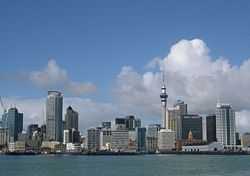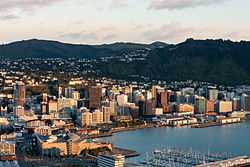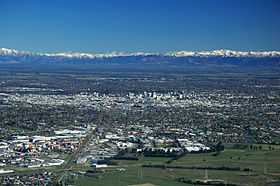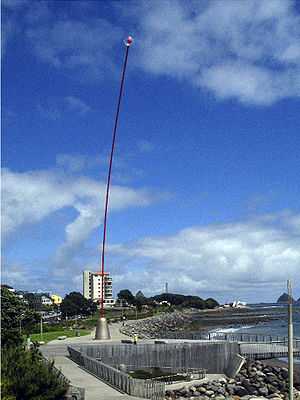List of cities in New Zealand
The word "city" began to take on two meanings in New Zealand after the local government reforms of 1989. Before the reforms, a borough council with more than 20,000 people could be proclaimed a city. The boundaries of councils tended to follow the edge of the built-up area, so there was little difference between the urban area and the local government area.
In 1989, the structure of the local governments in New Zealand was significantly reorganized. The new district councils and city councils were nearly always much larger geographically, and they covered both urban land and the surrounding rural land. Many locations that once had had a "city council" are now governed by a "district council".
The word "city" began to be used in a less formal sense to describe the urban areas of New Zealand, independent of local body boundaries. This informal usage is jealously guarded. The district government of the town of Gisborne, for example, adamantly described itself as the first "city" in the world to see the new millennium. However, Gisborne is governed by a "district council", though its status as a city is not generally disputed in New Zealand.
Today an urban area has to be at least 50,000 residents before it can be proclaimed as a city.[1]
Urban areas by population
The populations given in the table below are provisional New Zealand resident populations, June 2014 estimates,[2] and they refer to the entire urban area, unless otherwise stated.
| Rank (population) | Urban area | Population | Area (km²)[3] |
Population density (people/km²) |
Notes | |
|---|---|---|---|---|---|---|
| 1 | Auckland | 1,413,700 | 1,086 | 1,301.7 | ||
 Auckland, the largest city in New Zealand |
2 | Wellington | 393,600 | 444 | 886.5 | 1. |
 Wellington, the capital city of New Zealand |
3 | Christchurch | 375,200 | 608 | 617.1 | |
 Christchurch, the largest city in the South Island |
4 | Hamilton | 218,800 | 877 | 249.5 | 2. |
| 5 | Napier-Hastings | 128,800 | 375 | 343.5 | 3. | |
| 6 | Tauranga | 127,700 | 178 | 717.4 | ||
| 7 | Dunedin | 116,200 | 255 | 455.7 | ||
 Panorama of Dunedin |
8 | Palmerston North | 82,400 | 178 | 462.9 | |
| 9 | Nelson | 64,100 | 146 | 439.0 | ||
| 10 | Rotorua | 56,200 | 89 | 631.5 | ||
| Rotorua from Mt. Ngongotaha |
11 | New Plymouth | 55,600 | 112 | 496.4 | |
| 12 | Whangarei | 54,400 | 133 | 409.0 | ||
| 13 | Invercargill | 49,800 | 123 | 404.9 | ||
| Whanganui from Durie Hill |
14 | Whanganui (Wanganui) | 39,200 | 105 | 373.3 | |
| 15 | Gisborne | 35,400 | 85 | 416.5 |
Notes:
- Kapiti urban area (41,000) is the only Statistics New Zealand main urban area not listed. It spans the towns of Paekakariki, Paraparaumu, Raumati and Waikanae, and is not considered to be a city. It is part of the Greater Wellington Regional Council's area – though listed separately by Statistics New Zealand. Hundreds of people there commute daily to Wellington for work, and the suburban commuter rail network serves the Kapiti area. If Kapiti were added to Wellington the total population of the Wellington urban area would be approximately 440,000.
- The population for the Hamilton urban zone is 184,000, the Cambridge urban zone is 18,750 and the Te Awamutu urban zone is 16,100.
- The population figures for the Hastings urban zone is 67,800, and for Napier 61,100.
- Blenheim (30,200) is sometimes referred to as a city, especially by locals, although its former borough council was never proclaimed a city.
- Timaru (28,400) once had a city council, but is now administered by a district council. It is classified as a secondary urban area by Statistics New Zealand. It is still considered a city and the principal centre of South Canterbury. Road signs state "city centre" rather than "town centre".
- Pukekohe, a town not far south of Auckland, has an estimated population of 28,400.
- Taupo (23,400) is rarely referred to as a city.
- Masterton (20,800), the main centre in the Wairarapa, is rarely referred to as a city.
- Levin (20,300), the main centre in the Horowhenua district, is not considered to be a city.
- Tokoroa was long expected to become a city when its population continued to grow past 18,000 during the 1980s. However, with the fallback in the forestry industry, Tokoroa's main industry, many jobs were lost and Tokoroa's population declined. It now has 13,550 residents.
City councils
Populations of present-day councils
The populations given are the latest (June 2014 estimate)[2] Statistics New Zealand estimated resident populations.
| Rank (pop.) | City council | Population | First proclaimed |
|---|---|---|---|
| 1 | Auckland | 1,527,100 | 1871 |
| 2 | Christchurch | 362,000 | 1868 |
| 3 | Wellington | 200,100 | 1870 |
| 4 | Hamilton | 153,100 | 1936 |
| 5 | Dunedin | 124,600 | 1865 |
| 6 | Tauranga | 121,700 | 1963 |
| 7 | Lower Hutt | 101,700 | 1941 |
| 8 | Palmerston North | 84,300 | 1930 |
| 9 | Napier | 60,100 | 1950 |
| 10 | Porirua | 54,100 | 1965 |
| 11 | Invercargill | 53,700 | 1930 |
| 12 | Nelson | 49,300 | 1874 |
| 13 | Upper Hutt | 41,800 | 1966 |
Many cities were reorganised into districts by the Local Government Commission in 1989 under the Local Government Act 1974, for example, Timaru. The most recently proclaimed city is Tauranga, which became a city, for the second time, from 1 March 2004. Another former city is Rotorua. Some present cities, such as Christchurch (1862 and 1868) and Invercargill (1930 and 1991), have been declared cities more than once.
Under Section 27 of the Local Government Act 2002, a district may become a city by either a "reorganisation scheme" with the Local Government Commission, or under Section 27(1) it may apply for a change in status under Schedule 3, Clause 7. The new city must have "a population of not less than 50,000 persons", be "predominantly urban" and "a distinct entity and a major centre of activity within the region" (or regions) that it is encompassed by. Existing cities are grandfathered under Schedule 2, Part 2 of the Act. The only new city council so far under this section is the Tauranga City Council, from 1 March 2004.
Previously, under Section 37L of the Local Government Act 1974, new cities could only be formed from a "reorganisation scheme". The same criteria were used. The last city to be constituted under this section was Invercargill, which was re-reorganised into a city in 1991.
In 1991 the Lower Hutt City Council became the Hutt City Council by a special Act of Parliament that which did not change the name of the city of Lower Hutt; the city's coat of arms still refers to the "City of Lower Hutt".
Cities during provincialism, 1852 to 1876
During provincialism in New Zealand, from 1852 until abolition in 1876, there was no uniform system of local authorities in New Zealand. There is thus some argument over which of the following cities was the first.
- Nelson (1858, by Letters Patent)
- Christchurch (November 1862, revoked June 1868, both by provincial ordinance, and restored October 1868 by Act of Parliament)
- Otago (later Dunedin) (July 1865)
The Municipal Corporations Act 1876 included the first schedule of cities, with the dates they were constituted. Dunedin was the first city in New Zealand to be described in an Act of Parliament as 'City of...', something now automatic under the Local Government Act 2002.
- Dunedin (4 July 1865)
- Christchurch (28 May 1868)
- Wellington (16 September 1870)
- Auckland (24 April 1871)
- Nelson (30 March 1874)
Cities, 1877 to 1989
Up to October 1989, the Local Government Commission undertook reorganisations of local government. As a result, some cities were reorganised into other cities or changed to districts, and some of these areas are still considered cities by many New Zealanders. This is a list as at circa 1986.
- North Island
- Whangarei (1964)
- Auckland
- Auckland (1871)
- East Coast Bays
- Takapuna
- Birkenhead
- Waitemata (1974)
- Mt Albert
- Papatoetoe
- Manukau (1965)
- Papakura
- Tamaki
- Hamilton (1936)
- New Plymouth (1949)
- Tauranga (1963)
- Bethlehem
- Mount Maunganui
- Papamoa
- WelcomeBay
- Rotorua (1962, merged into Rotorua District, 1979)
- Gisborne (1955)
- Napier (1950)
- Hastings (1956)
- Wanganui (1924)
- Palmerston North (1930)
- Wellington
- Wellington (1870)
- Upper Hutt (1966)
- Lower Hutt (1941)
- Porirua (1965)
- South Island
- Nelson (1874)
- Christchurch (1868)
- Timaru (1948)
- Dunedin (1865)
- Invercargill (1930)
See also
- City status in the United Kingdom
- List of towns in New Zealand
- List of main streets of New Zealand cities
- Ranked list of New Zealand urban areas
- Territorial authorities of New Zealand
Notes
- ↑ http://www.stats.govt.nz/Census/about-2006-census/2006-census-definitions-questionnaires/definitions/geographic.aspx
- ↑ 2.0 2.1 "Subnational Population Estimates: At 30 June 2014 (provisional)". Statistics New Zealand. 22 October 2014. Retrieved 2 November 2014. Also "Infoshare; Group: Population Estimates - DPE; Table: Estimated Resident Population for Urban Areas, at 30 June (1996+) (Annual-Jun)". Statistics New Zealand. 22 October 2014. Retrieved 2 November 2014.
- ↑ "Freedom from Crowding: Living Density Table 1". Statistics New Zealand. Retrieved 28 January 2010. (Areas are based on 2001 boundaries. Water bodies of areas greater than 15 hectares are excluded)
References
- Gordon McLauchlan (Editor), Illustrated Encyclopedia of New Zealand, The, Auckland: David Bateman, 1989 (second edition) (ISBN 1-86953-007-1) - confirmation, pre-1989 dates
External links
- Statistics New Zealand Subnational Population Estimates
- Tauranga status change, 2003 - specific details
- Local Government (Tauranga City Council) Order 2003 (Governor-General's Order-in-Council, 2 October 2003)
- Local Government Commission press release (PDF)
- Local Government Commission decision full text (PDF)
- Tauranga's city status returns (New Zealand Herald, 12 August 2003)
- Local Government Online Limited site - confirmation, post-1989 council names
- Map
| ||||||||||||||||||||||
| |||||||||||||||||||||||||||||||||||||||||||||||||||||
| ||||||||||||||











